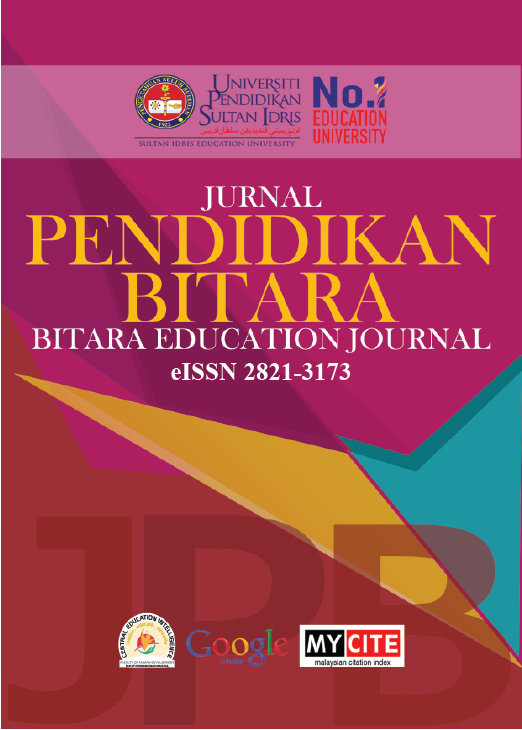Cyberbullying and emotional implications among secondary school students
Buli siber dan implikasi emosi dalam kalangan murid sekolah menengah
DOI:
https://doi.org/10.37134/bitara.vol14.1.7.2021Keywords:
Cyberbullying, Emotional Implication, Well-beingAbstract
Nowadays research on cyberbullying is conducted tremendously especially involving high school students. The negative impacts of the phenomena that could contribute harm to high school students’ development and well-being are the reasons Malaysian researchers and others became aware of the topic. This study examines the cyberbullying situation and its implications on the emotional, motivational and social aspects among high school students at Bandar Seberang Jaya, Pulau Pinang. The focus of this study is to identify the situation regarding cyberbullying, as well as its implications towards the emotional stability of students from Bandar Seberang Jaya, Pulau Pinang. This research survey involved 250 samples from high schools in Bandar Seberang Jaya, Pulau Pinang. The questionnaire used was developed by the researcher which contained two main aspects such as cyberbullying situations and emotional implication. The output for the pilot test gained from Cronbach alpha analysis which examined all aspects of the questionnaire have shown high value which is (>0.8). The data are analyzed descriptively and inferentially in terms of frequency, percentage, min and correlation. The analyzed data showed that the cyberbullying situation is at a lower level i.e. 2.07 points. As for the correlation analysis, there is no significant difference between cyberbullying and its impact towards emotions. As a conclusion, immediate action should be taken to help implicate the rising case of cyberbullying amongst high school students as it could bring an impact on their behavioral change. The collaboration of all parties and the stern actions by authorities is highly recommended to manage and identify some effective measures to ensure the well-being of the next generation so they will contribute to the national development and harmony.
Downloads
References
Alzahrin Alias & Mohd Nasaruddin Parzi. (2015). Remaja terpengaruh media sosial. BHPlus, 1-10.
Caravita, S. C., Colombo, B., Stefanelli, S. & Zigliani, R. (2016). Emotional, psychophysiological and behavioral responses elicited by the exposition to cyberbullying situations: Two experimental studies. Psicologia educativa, 22(1), 49-59.
DePaolis, K. J. & Williford, A. (2019). Pathways from cyberbullying victimization to negative health outcomes among elementary school students: A longitudinal investigation. Journal of Child and Family Studies, 28(9), 2390-2403.
Heiman, T., Olenik-Shemesh, D. & Eden, S. (2015). Cyberbullying involvement among students with ADHD: Relation to loneliness, self-efficacy and social support. European Journal of Special Needs Education, 30(1),15-29.
Helma Hassan. (2018). Buli siber di Malaysia. Buletin Kesihatan, 1-7.
Kalaisilven, S. & Mohamad Fauzi Sukimi (2019). Kawalan ibu bapa terhadap anak-anak dalam penggunaan media sosial (Parental control over children in the use of Social media). Akademika, 89(1).
Yatiman Karsodikromo, Mohd Razimi Husin, Abdul Rahim Razali & Hazalizah Hamzah. (2020). Buli siber dalam kalangan murid sekolah menengah di daerah Samarahan, Sarawak. Jurnal Pendidikan Bitara UPSI, 13(2), 38-47.
Krejcie, R. V. & Morgan, D. W. (1970). Determining sample size for research activities. Educational and Psychological Measurement, 30(3), 607-610.
On The Alert For Cyberbullying-Letters. (2017). The Star Online, 1-4.
Peled, Y. (2019). Cyberbullying and its influence on academic, social, and emotional development of undergraduate students. Heliyon, 5(3).
Safiek Mokhlis. (2019). Buli siber dalam kalangan pelajar sekolah menengah: Satu penerokaan awal. Jurnal Dunia Pendidikan, 1(2), 7-18.
Simon, S. (2017). Cybervictimization: School experience of Malaysian cyberbullied teenagers. International Journal of Humanities and Social Sciences, 11(3), 713-720.
Siti Zarinah Sahib. (2019). Cegah Buli Siber. Harian Metro, 1-6.
Zalaquett, C. P. & Chatters, S. J. (2014). Cyberbullying in college: Frequency, characteristics, and practical implications. Sage Open, 4(1).
Zuhayati Yazid (2017). SKMM terima 38 kes aduan buli siber dalam tempoh 11 bulan tahun ini. Nasional-UtusanOnline,1-7.





